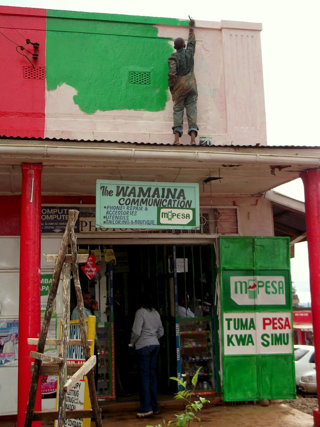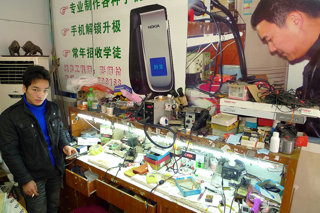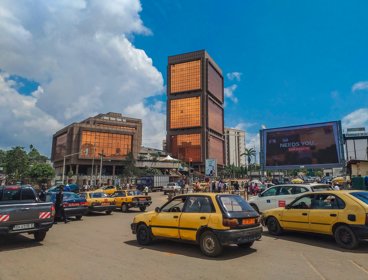His research focuses on technologies and innovation in developing and emerging markets, with a particular interest on how ICTs can help support development of low income groups. He also works as a consultant to a number of NGOS working in Africa. We spoke to Chris about his work on the ICTs and development, in particular about the growth of mobile ICTs in Kenya.
In what ways do you think ICTs can contribute towards development in the countries you have been researching?
In recent years a mass of interventions around ICT have looked to push development. Examples which include mobile technologies have been developed that allow smallholders and farmers to link into markets, e-health systems have been developed to help enhance delivery in under-resourced hospitals and NGOs who have increasingly integrating technologies to better manage their projects. Not every project is successful, far from it, but we can say that ICT is increasingly an integral part of many development interventions.
But, we must not also forget the wider picture around the growing adoption of ICTs and internet based technologies in developing and emerging countries. So beyond development interventions, it is important to study the effects of ICTs (both positive and negative) on individuals, firms, politics and societies.
Are there any specific uses of ICTs which have been particularly successful or have made a real impact?
One ICT that has been much talked about in developing countries is the mobile phone which has high rates of ownership, even amongst low income groups. A number of uses of phones have had a high impact, using mobile technology for improved information and communications as a way to help improve livelihoods. Often such use have been quite simple – mobile money is the best example, but there are others like SMS emergency warning systems for disasters and mobile helplines for farmers which have been scaled to national level, and found to be impactful.
Could you explain a little bit how mobile money works?
Mobile money is a service that allows mobile phone users the ability to store and transfer money from their mobile phone. Users register their phone SIM card and their mobile number acts as their account identifier. They can then transfer money to other account holders using phone messaging. To withdraw money you simply visit a cash ‘agent’, who are ever present in places like Kenya, they act a bit like a less formal banker who will deduct money from your account and give you cash.
So you can think of mobile money like a mobile phone bank account and in Kenya it is massively popular. 2012 statistics suggest that around 75% of Kenya’s adult population are registered with M-Pesa the world’s first mobile money service, with £410million moving in the system on a monthly basis and over 30,000 agents in the country.

M-Pesa Mobile Money Agent in Kenya. Source: Flickr user Erickt19
What advantages did mobile money bring to the people that were involved?
Mobile money has a number of benefits. It allows users to safely store money and more securely transfer money, even to those located in the most rural areas. This may sound minor but it has had significant effects on business, particularly in supporting the ways that small and informal business can trade more easily. It also allows families spread throughout Kenya to easily share financial burdens and support each other through remittances.
Other researchers are working on how mobile money provides possibility to help improve financial integration of low income users, and how mobile money might encourage other finance mechanisms such as insurance for farmers, micro-finance and savings.

Using Mobile Money for Flights in Kenya.
Do you think mobile money is a solution which could be applied across many other developing countries or are there factors which affect its success?
Yes, I think that such service could be useful for widely. Mobile money services were first created in Kenya and following its’ massive success have been replicated across a number of developing countries. The service has been somewhat successful in some places, such as neighbouring Uganda and Tanzania, but in other places such as India and Nigeria it has been slower to take off.
There has been huge debate as to why this is, but I can give my view. In some senses, I think it relates to the conditions of Kenya: the fact that only one mobile firm has a large majority of subscribers, allowing the service to grow quickly; and the presence a dynamic lead firm and policy makers in Kenya which might not exist elsewhere.
However, I think it goes deeper than this. M-Pesa service fits so well to Kenya because it was designed and adapted in the slum area of Nairobi with low income users in mind. When it is applied in other countries it is often replicated without much thought, but there is no reason why something created in Kenya would fit so well in other places. So I think that when mobile money is introduced elsewhere firms and policy makers need to examine more closely how to adapt the technologies to their own contexts.
What other kinds of innovation is being seen in the emerging markets you are researching?
My work has looked at local adaption of ICTs, the fact that as ICT diffuse into developing and emerging markets they are used in unexpected and often innovative ways. These local adaptations are often ignored when a top-down view of ICT are taken, but my work suggests that these adaptations can lead to new applications or more appropriate ICTs for low income groups, and if captured can have more widespread impact.
Examples of such local adaptation vary across economies. For instance in places like Kenya, you can see lot of unintended and interesting uses of mobile money that fit into this idea. In more emerging economies like India and China such adaptions can be more radical, for instance back street mobile repairs have been known to adapt and enhance mobile phones to fit with their users.

Mobile phone repair workshop in China. Source: Flickr user marco bono
What factors are affecting the success of innovation and technology in emerging markets?
There are many factors that affect how successful ICTs and innovations are, either as development interventions or in markets. Technologies need to be appropriate for their audience or market, and care must be taken to ensure that they are sustainable, available and affordable as they scale.
One area that I have done some work on is to examine policies that support more inclusive innovations in ICT. Typically when people talk about ICT policy they often talk about the need for ‘enabling environments’ and competition. Whilst my work supports this, it also shows that more active policy can be important in encouraging innovation, particularly for spurring low income use through measures that support demand, micro-enterprises and appropriate innovation.
Chris was interviewed in March 2014




